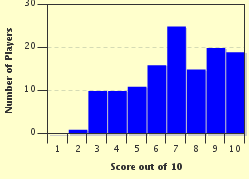Quiz Answer Key and Fun Facts
1. In the constellation Orion, the indicated star is known by the Bayer designation 'Alpha Orionis'. By what other name is this red supergiant known?
2. Orion's Belt is composed of three main stars, their Bayer designations Zeta, Epsilon, and Delta Orionis. Which of these is NOT one of the common names of the stars of Orion's Belt?
3. The seven stars that make up Big Dipper make up the entirety of the constellation Ursa Major.
4. Merak (Alpha Ursae Majoris) and Dubhe (Beta Ursae Majoris) have another job, apart from being part of a constellation. When an imaginary line is drawn from them, they indicate the location of the North Star. For this reason, Merak and Dubhe are also known by what nickname?
5. The North Star is a colloquial name for Alpha Ursae Minoris, the brightest star of the constellation Ursa Minor. What is its actual name?
6. At the opposite end of Ursa Minor from Polaris are the two stars Pherkad and Kochab. By what nickname are they known?
7. This distinctive 'W' (or 'M') seen in our sky is made up of five stars named Segin, Ksora, Cih, Shedir and Caph (in order in the photo). What is the name of this constellation?
8. North of Shedar and northeast of Caph is located the remnant of a supernova that was observed between 1572 and 1574. Although he was not the first to discover it, which astronomer's name has been associated with this supernova after writing the treatise "Concerning the Star, new and never before seen in the life or memory of anyone"?
9. Alright, so the Summer Triangle is an asterism and not a constellation, but I like it anyways. It is visible in northern latitudes from spring through to autumn, but is most prominently overhead in the summer. What third smallest constellation lies completely within the Summer Triangle?
10. Deneb, Vega and Altair make up the points of the Summer Triangle, but each of them have their own constellations. Which of these constellations is not involved?
Source: Author
reedy
This quiz was reviewed by FunTrivia editor
rossian before going online.
Any errors found in FunTrivia content are routinely corrected through our feedback system.
